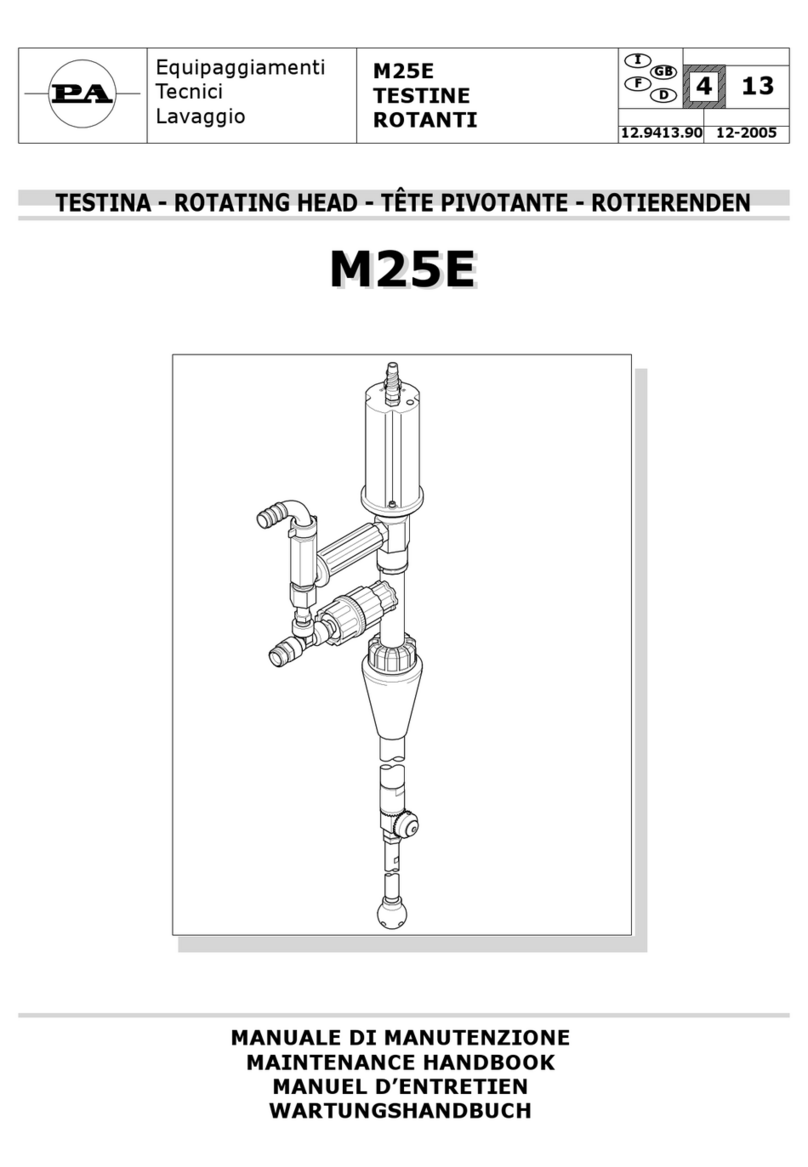
ITALIANOENGLISHFRANÇAISDEUTSCH
8
ITALIANO ENGLISH FRANÇAIS DEUTSCH
9
@ A questo punto risultano visibili i satelliti superiori. Per estrarli servirsi di una pinza come in g.8,
facendo attenzione a non danneggiare i denti. I satelliti sono disposti su tre piani col relativo por-
tasatellite. Questa operazione pertanto è da ripetere per ognuno.
I Per ogni satellite è necessario vericare: l’usura del diametro interno (accertarsi che non sia ecces-
sivo il gioco una volta montato sul suo perno), l’usura e l’integrità dei denti.
I Del portasatellite occorre vericare l’usura dei tre perni superiori e lo stato dei denti nella parte
inferiore.
I I due portasatelliti superiori sono dotati di una pasticca (A, g.8) che li distanzia dal portasatellite
che sta sotto. Anche questa deve essere vericata.
MI satelliti superiori, ruotando a velocità più elevate, sono maggiormente soggetti ad usura. E’ con-
sigliabile quindi effettuare una “rotazione” dei gruppi di satelliti all’atto del montaggio, invertendo
primo e l’ultimo gruppo (vedere “montaggio/manutenzione).
@ At this point the upper pinions can be seen. To extract them use pliers as shown in g.8, being careful
not to damage the teeth. The pinions are positioned on three levels with relative pinion-carriers.
Therefore this operation has to be repeated for each one.
I Check the following for each pinion: the wear of the internal diameter (make sure that the slack
is not excessive after it has been mounted on its pivot), the wear of the teeth and that they are
intact.
I Check the wear of the upper three pivots of the pinion-carrier and the state of the teeth in the lower
part.
I The two upper pinion-carriers are equipped with a pad (A, g.8) that separates them from the
pinion-carrier which is below. This also has to be checked.
MThe upper pinions, rotating at higher speeds, are subject to greater wear. Therefore we advise car-
rying out a “rotation” of the pinion groups when assembling, inverting the rst and the last group
(see “assembling/maintenance).
@ Les satellites supérieurs sont maintenant visibles. Pour les extraire, se servir d’une pince comme le
montre la g.8 en veillant à ne pas abîmer les dents. Les satellites sont disposés sur trois étages
avec leur porte-satellite. Cette opération doit donc être répétée pour chacun.
I Pour chaque satellite, il faut vérier : l’usure du diamètre interne (s’assurer qu’il n’y a pas de jeu
excessif une fois monté sur son axe), l’usure et l’intégrité des dents.
I Sur le porte-satellite, il faut vérier l’usure des trois axes supérieurs et l’état des dents dans la
partie inférieure.
I Les deux porte-satellites supérieurs sont munis d’une plaquette (A, g.8) qui les espace du porte-
satellite qui se trouve dessous. Celle-ci aussi doit être contrôlée.
MLes satellites supérieurs, en tournant plus vite, sont davantage sujets à usure. Nous conseillons
donc d’effectuer une “rotation” des groupes de satellites au moment du montage, en inversant le
premier et le dernier groupe (voir “montage/entretien”).
@ An diesem Punkt sind die oberen Satelliten sichtbar. Zum Herausziehen eine Zange verwenden wie auf Abb. 8
gezeigt und darauf achten, dass die Zähne nicht beschädigt werden. Die Satelliten sind mit der entsprechenden
Halterung auf drei Ebenen angeordnet. Dieser Vorgang muss daher für jede Ebene wiederholt werden.
I Bei jedem Satelliten müssen überprüft werden: die Abnutzung des Innendurchmesser (sicherstellen, dass
nach dem Einbau auf dem Bolzen nicht zu viel Spiel vorhanden ist), die Abnutzung sowie die Unversehrtheit
der Zähne.
I An der Satellitenhalterung müssen die Abnutzung der drei oberen Bolzen und der Zustand der Zähne im unteren
Teil überprüft werden.
I Die beiden oberen Satellitenhalterungen weisen einen Belag auf (A, Abb.8), der den Abstand zu dem darunter
bendlichen Satellitenhalterung herstellt. Auch dieser muss überprüft werden.
MDie oberen Satelliten drehen sich mit ausgesprochen hoher Geschwindigkeit und sind daher einem größeren
Verschleiß ausgesetzt. Daher wird empfohlen, bei Einbau eine “Rotation” der Satellitengruppen vorzunehmen
78
B
und die erste mit der letzten Gruppe zu vertauschen.





























